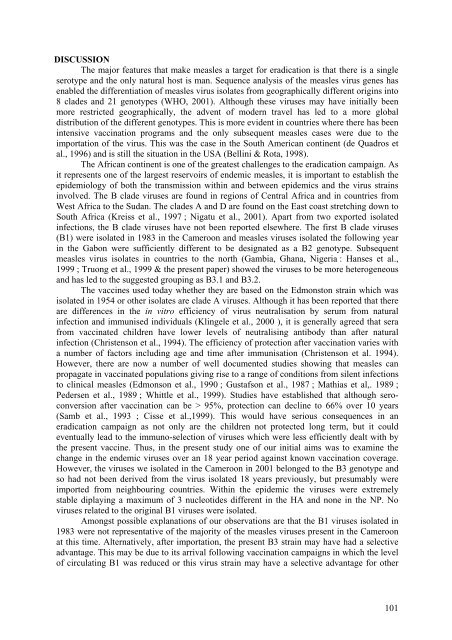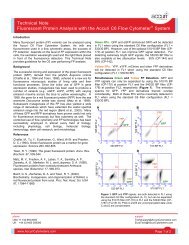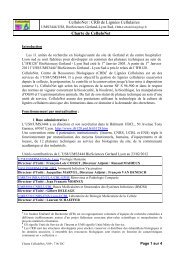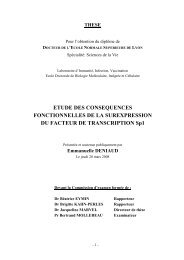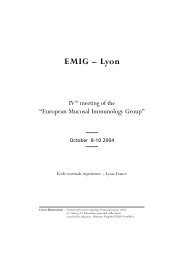SOUCHES AFRICAINES DU VIRUS DE LA ROUGEOLE : ETUDE ...
SOUCHES AFRICAINES DU VIRUS DE LA ROUGEOLE : ETUDE ...
SOUCHES AFRICAINES DU VIRUS DE LA ROUGEOLE : ETUDE ...
You also want an ePaper? Increase the reach of your titles
YUMPU automatically turns print PDFs into web optimized ePapers that Google loves.
DISCUSSION<br />
The major features that make measles a target for eradication is that there is a single<br />
serotype and the only natural host is man. Sequence analysis of the measles virus genes has<br />
enabled the differentiation of measles virus isolates from geographically different origins into<br />
8 clades and 21 genotypes (WHO, 2001). Although these viruses may have initially been<br />
more restricted geographically, the advent of modern travel has led to a more global<br />
distribution of the different genotypes. This is more evident in countries where there has been<br />
intensive vaccination programs and the only subsequent measles cases were due to the<br />
importation of the virus. This was the case in the South American continent (de Quadros et<br />
al., 1996) and is still the situation in the USA (Bellini & Rota, 1998).<br />
The African continent is one of the greatest challenges to the eradication campaign. As<br />
it represents one of the largest reservoirs of endemic measles, it is important to establish the<br />
epidemiology of both the transmission within and between epidemics and the virus strains<br />
involved. The B clade viruses are found in regions of Central Africa and in countries from<br />
West Africa to the Sudan. The clades A and D are found on the East coast stretching down to<br />
South Africa (Kreiss et al., 1997 ; Nigatu et al., 2001). Apart from two exported isolated<br />
infections, the B clade viruses have not been reported elsewhere. The first B clade viruses<br />
(B1) were isolated in 1983 in the Cameroon and measles viruses isolated the following year<br />
in the Gabon were sufficiently different to be designated as a B2 genotype. Subsequent<br />
measles virus isolates in countries to the north (Gambia, Ghana, Nigeria : Hanses et al.,<br />
1999 ; Truong et al., 1999 & the present paper) showed the viruses to be more heterogeneous<br />
and has led to the suggested grouping as B3.1 and B3.2.<br />
The vaccines used today whether they are based on the Edmonston strain which was<br />
isolated in 1954 or other isolates are clade A viruses. Although it has been reported that there<br />
are differences in the in vitro efficiency of virus neutralisation by serum from natural<br />
infection and immunised individuals (Klingele et al., 2000 ), it is generally agreed that sera<br />
from vaccinated children have lower levels of neutralising antibody than after natural<br />
infection (Christenson et al., 1994). The efficiency of protection after vaccination varies with<br />
a number of factors including age and time after immunisation (Christenson et al. 1994).<br />
However, there are now a number of well documented studies showing that measles can<br />
propagate in vaccinated populations giving rise to a range of conditions from silent infections<br />
to clinical measles (Edmonson et al., 1990 ; Gustafson et al., 1987 ; Mathias et al,. 1989 ;<br />
Pedersen et al., 1989 ; Whittle et al., 1999). Studies have established that although seroconversion<br />
after vaccination can be > 95%, protection can decline to 66% over 10 years<br />
(Samb et al., 1993 ; Cisse et al.,1999). This would have serious consequences in an<br />
eradication campaign as not only are the children not protected long term, but it could<br />
eventually lead to the immuno-selection of viruses which were less efficiently dealt with by<br />
the present vaccine. Thus, in the present study one of our initial aims was to examine the<br />
change in the endemic viruses over an 18 year period against known vaccination coverage.<br />
However, the viruses we isolated in the Cameroon in 2001 belonged to the B3 genotype and<br />
so had not been derived from the virus isolated 18 years previously, but presumably were<br />
imported from neighbouring countries. Within the epidemic the viruses were extremely<br />
stable diplaying a maximum of 3 nucleotides different in the HA and none in the NP. No<br />
viruses related to the original B1 viruses were isolated.<br />
Amongst possible explanations of our observations are that the B1 viruses isolated in<br />
1983 were not representative of the majority of the measles viruses present in the Cameroon<br />
at this time. Alternatively, after importation, the present B3 strain may have had a selective<br />
advantage. This may be due to its arrival following vaccination campaigns in which the level<br />
of circulating B1 was reduced or this virus strain may have a selective advantage for other<br />
101


